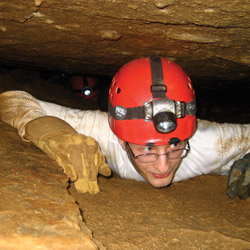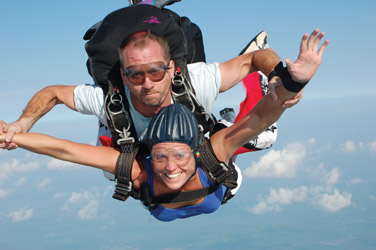The ways in which we experience certain things in life depend a lot on what we’re doing. Take the four classical elements—earth, air, water and fire. We experience each of these things on a daily basis with scarcely a thought…but the more adventurous among us see a completely different side of these essential building blocks.
The Underside of the Earth
What better way to experience the earth than to get right down in it? Located in southern Indiana, Marengo Cave is the closest destination to Peoria for extreme caving. For the time being, all of the public caves in Illinois—and throughout most of the Midwest—are closed in order to combat the spread of a deadly bat disease called white nose syndrome. Marengo Cave remains open to the public, providing an opportunity to delve deep into the earth and experience unique formations and life forms.
 Caves have been explored as long as man has been on the earth, but it wasn’t until the early 20th century that the sport of caving started gaining popularity. Since then, both scientific and recreational caving have advanced, especially in terms of safety measures and the depths explored.
Caves have been explored as long as man has been on the earth, but it wasn’t until the early 20th century that the sport of caving started gaining popularity. Since then, both scientific and recreational caving have advanced, especially in terms of safety measures and the depths explored.
Guided tours at Marengo Cave are led by individuals trained to interpret the cave environment and talk about conservation and stewardship, offering visitors a one-of-a-kind experience. “You can do a lot of high-adventure things on the surface,” said Marengo Cave’s Carol Groves, “but there’s nothing quite comparable to going into a space that’s pitch-black…It’s mysterious and unknown.”
The adventurous can explore Old Town Spring Cave on Marengo’s Underground Adventure trip, or visit one of Indiana’s largest underground springs in the Waterfall Crawl. Expect to get wet and dirty as you spend two hours crawling around and winding through underground tunnels and caverns. The only light you’ll see will come from your headlamp! Explorers must be at least 10 years old and register two weeks in advance.
But experiencing the earth from beneath its surface isn’t for everyone. For the less adventurous, Marengo Cave offers guided walking tours on lit pathways through the cave’s upper level. While still a fun learning experience, these tours are much cleaner and less intense. For more information, visit marengocave.com.
Dive Into Thin Air
Most of our experience with air consists of breathing and feeling the wind in our hair—pretty mild stuff! But those willing to strap on a parachute and launch themselves out of an airplane experience this element in a completely different way.
While parachutes have been used since the 12th century, skydiving has its roots in the late 1700s, when display jumps were performed from balloons. The military began using parachutes as rescue devices during World War I, but pilots didn’t bail out of their planes until the 1920s, about the time the first experiments with “stable, extended freefall” began, according to the U.S. Parachute Association.
Those adventurous enough to try extended freefall have a number of options. Thrill-seekers just looking to check skydiving off their bucket lists may prefer a place like Skydive Chicago in Ottawa, where they will complete an hour-long safety class before making a tandem jump—skydiving while harnessed to a certified instructor. Those looking for more of a hobby may favor the Illinois Valley Parachute Club in Minier, where they can take classes and make jumps in a progressive program leading to certification.
At IVPC, students make their first jump at about 3,500 feet above ground level using a static line. One end of a nylon strap is attached to the aircraft and the other to the skydiver; the parachute opens automatically as the diver falls away from the plane. Students must show proficiency at getting out of the airplane, holding a stable body position, and using a practice ripcord before they can advance to higher-altitude jumps that allow for more freefall time.
 Skydive Chicago uses a larger airplane and can take skydivers up to 13,500 feet above the ground, allowing for about 60 seconds of freefall before the parachute opens. It also offers a certification program. For details on the certification process, prices and schedules, contact IVPC at ivpc.org or (309) 392-2751, or Skydive Chicago at skydivechicago.com or (815) 433-0000.
Skydive Chicago uses a larger airplane and can take skydivers up to 13,500 feet above the ground, allowing for about 60 seconds of freefall before the parachute opens. It also offers a certification program. For details on the certification process, prices and schedules, contact IVPC at ivpc.org or (309) 392-2751, or Skydive Chicago at skydivechicago.com or (815) 433-0000.
Explore Deep Waters
While underwater diving has roots dating back to the fourth century, scuba diving as we know it today originated during World War II, said Steve Bishop, president and instructor at Deep Blue Adventure, one of three scuba stores in the Peoria area. Civilian diving, he added, didn’t really begin until the 1950s, when the equipment became more accessible and affordable to the public.
Many of us equate scuba diving with the tropics, but the Midwest is actually a strong center for diving, said Bishop. “Even though we’re a little short of beaches, we do have an abundance of wrecks in the Great Lakes. Living in central Illinois also has the benefit of having the Atlantic, Pacific and Gulf coasts reasonably accessible.”
With more than 20,000 wrecks sitting at the bottom of the Great Lakes, local divers have a plethora of opportunities to test their skills in deep waters. And for those more interested in tropical waters, all three local shops offer occasional group trips, as well as training and certification classes for ages 10 and up.
Scuba certification classes are split into three sections and last about five weeks—classroom learning at the scuba shop, confined water training in a pool, and open water training that can be done at one of three local lakes or quarries, or on a group trip. Deep Blue Adventure provides the necessary gear and encourages students to try different brands and styles to find what works best for them.
“Scuba is a hobby that can go as far as the individual diver would like to take it,” Bishop explained. After completing open water certification, individuals can dive to a depth of 60 feet. To further their training, divers can proceed to advanced open water certification, which allows them to dive up to 100 feet below the surface. “In addition,” Bishop continued, “there are a broad variety of ‘specialty’ certifications…from underwater photography to night diving to diver propulsion vehicles [underwater scooters].” For more info, call Deep Blue Adventure at (309) 685-4294 or visit deepblueadventure.com.
Ready, Aim, Fire!
Competitive shotgun shooters have been honing their skills at trap shooting since the late 18th century. Sporting clays came into play in the 1880s, and in the early 1900s, the game of skeet arose. Where shooters of skeet and trap are in fixed locations firing at targets that travel the same path each time, sporting clays requires the shooter to move through a course, simulating live game hunting more closely, with a few added variables.
In central Illinois, skeet and trap shooting seem to be preferred to sporting clays, and the Peoria Skeet and Trap Club has focused on drawing more people to these two sports. Originally located where the McClugage Bridge now stands, the club moved to its present location in the early ‘60s. Open year-round, club members and the general public are encouraged to shoot in leagues and competitions.
According to Club President Mike Dennis, skeet and trap shooting are both performed with shotguns and involve shooting at targets sent into the air from small structures called trap houses. In skeet, clay targets come out of two houses, one low and one high, and the shooter moves through eight stations, shooting 25 targets in all. In trap, targets are sent airborne from a single trap house, and the shooter shoots at five targets at each of five stations. Many shooters participate in the sports as a way to enter into friendly competition—the fact that they can keep their hunting skills sharp while out of season is an added bonus!
The Peoria Skeet and Trap Club has an active membership of about 250, but many more use its facilities and participate in its leagues. The club offers a youth training program, as well as individualized instruction. “It’s a good group of people out there…that is really trying to advance the sport,” explained Dennis, “and we’re making a lot of improvements and just trying to get more younger people to join.” For more info on skeet and trap shooting or the Peoria Skeet and Trap Club, call (309) 822-8146 or visit peoriaskeetandtrap.com. a&s


